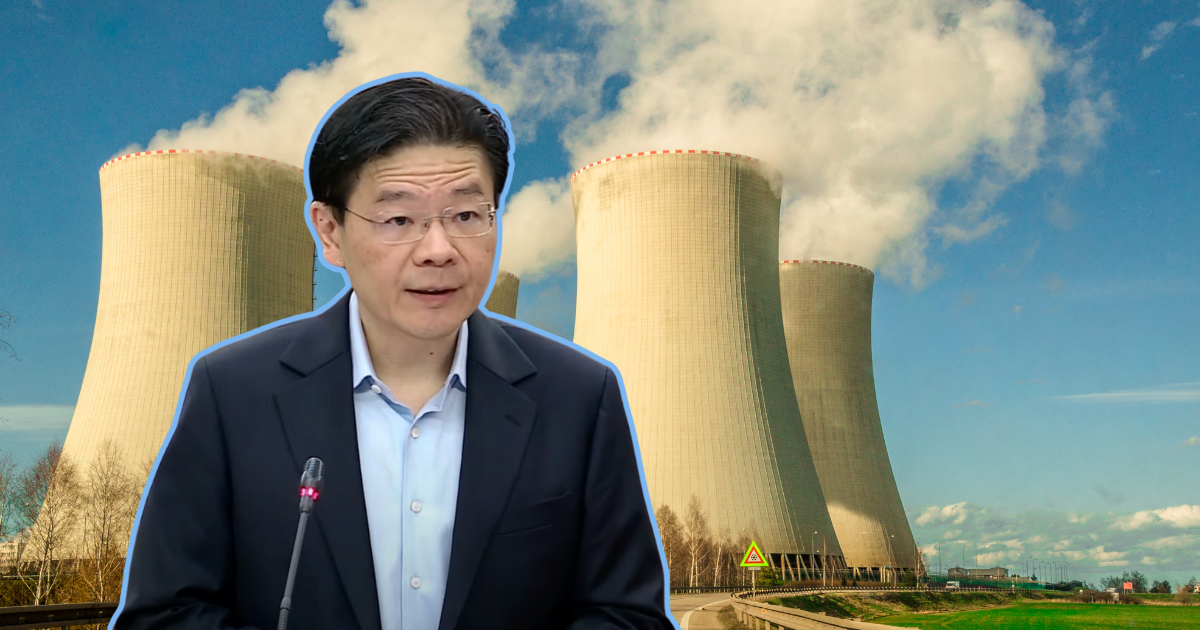The world has been crazy about climate change.
For developed countries like Singapore, efforts to save the world include reducing our plastic straw intake, carrying our tote bag instead of paying 10 cents for an NTUC plastic bag, and feeling slightly better about ourselves if we bring our own tumblers to a cafe.
But let’s be real — while these efforts help, the biggest game-changer for the environment is shifting away from fossil fuels. And that means looking at cleaner energy alternatives.
Fossil fuels have been our go-to energy source for decades, but there’s one small problem: they release massive amounts of carbon dioxide when burned.
This isn’t rocket science. It’s basic primary school chemistry if you have been paying attention.
More carbon dioxide means more greenhouse gases, which means hotter temperatures, and melting ice caps, amongst others.
So, what’s the alternative?
If there’s one greener source of energy, it’s nuclear power.
On 18 February, during the Budget 2025 speech, Prime Minister Lawrence Wong announced that Singapore is officially studying nuclear energy as a potential clean energy solution.
Currently, Singapore has limited access to renewable energy sources like hydro, wind, and even large-scale solar farms. With rising energy consumption, thanks to industries like artificial intelligence, semiconductors, and biopharmaceuticals, there’s a need for long-term, sustainable solutions.
What is Nuclear Power?
Before we dive deeper, let’s clear up the basics: what exactly is nuclear power, and how does it work?
To put it simply, nuclear power is energy generated from the nucleus (the core) of atoms, which are made up of protons and neutrons. This energy is released through two processes.
This source of energy can be produced in two ways: fission – when nuclei of atoms split into several parts – or fusion – when nuclei fuse.
Additional $5 Billion Into Future Energy Fund
To support Singapore’s clean energy future, PM Wong also announced an additional $5 billion injection into the Future Energy Fund, bringing the total fund to a whopping $10 billion.
This fund will be used to explore various clean energy solutions, including nuclear power, hydrogen, and electricity imports.
Singapore has always been big on innovation. Just look at how we turned wastewater into clean drinking water (shoutout to Newater).
This investment aims to develop high-cost, high-risk energy technologies that could be pivotal to Singapore’s long-term sustainability.
The government will assess the feasibility of nuclear energy while also building the expertise required to evaluate its options in a safe and cost-effective manner.
This decision comes at a time when regional interest in nuclear power is growing, with countries like Malaysia and Indonesia already operating research reactors.
PM Wong also noted that global interest in nuclear energy is steadily increasing.
Tackling New Energy Challenges
PM Wong highlighted that today’s world presents new energy challenges. With industries like artificial intelligence, semiconductors, and biopharmaceuticals consuming massive amounts of power, energy demand is set to skyrocket.
To meet these growing needs while keeping carbon emissions in check, he stressed that expanding access to clean energy is crucial.
Currently, natural gas supplies about 95 per cent of Singapore’s energy, with the power sector responsible for 40 per cent of the nation’s total emissions.
To hit its net-zero target by 2050, Singapore must cut emissions from this sector significantly.
While no decision has been made on adopting nuclear energy, it remains on the table as one of several low-carbon options.
Of course, the word “nuclear” can be a little scary. When people hear it, they often think of disasters like Fukushima. But that’s not the nuclear we are referring to here.
PM Wong emphasised that safety is a top priority, and any decision to adopt nuclear energy will depend on whether it meets Singapore’s strict safety and environmental standards.
One option being explored is Small Modular Reactors (SMRs), which are more compact, have enhanced safety features, and are designed for urban environments. Several SMRs are already operational worldwide, and more are expected to be up and running by the end of the decade.
Imports of Low-Carbon Electricity
Even as Singapore explores nuclear power, it’s not the only strategy on the table. The country is also increasing electricity imports from neighbouring countries.
Agreements have already been signed with Indonesia, Cambodia, and Vietnam to import 5.6 gigawatts of low-carbon electricity by 2035, primarily from solar, hydro, and wind sources.
The expansion of a pilot project in 2024 will allow Singapore to import hydropower from Laos through Thailand and Malaysia.
Meanwhile, imports from Malaysia will increase from 100 MW to 200 MW by late 2024. By 2035, it’s expected that one-third of Singapore’s electricity will come from imports.
Evaluation of Low-Carbon Hydrogen
Another potential clean energy source Singapore is eyeing is low-carbon hydrogen, which doesn’t release harmful emissions when burned.
However, hydrogen production, storage, and transportation are still expensive and complicated to scale.
PM Wong acknowledged these challenges, stating that while hydrogen has great potential, there’s still a long way to go before it becomes a viable mainstream energy source.
If you watch at least 10 minutes of brain rot content daily, you must know this:

Read Also:
Advertisements

